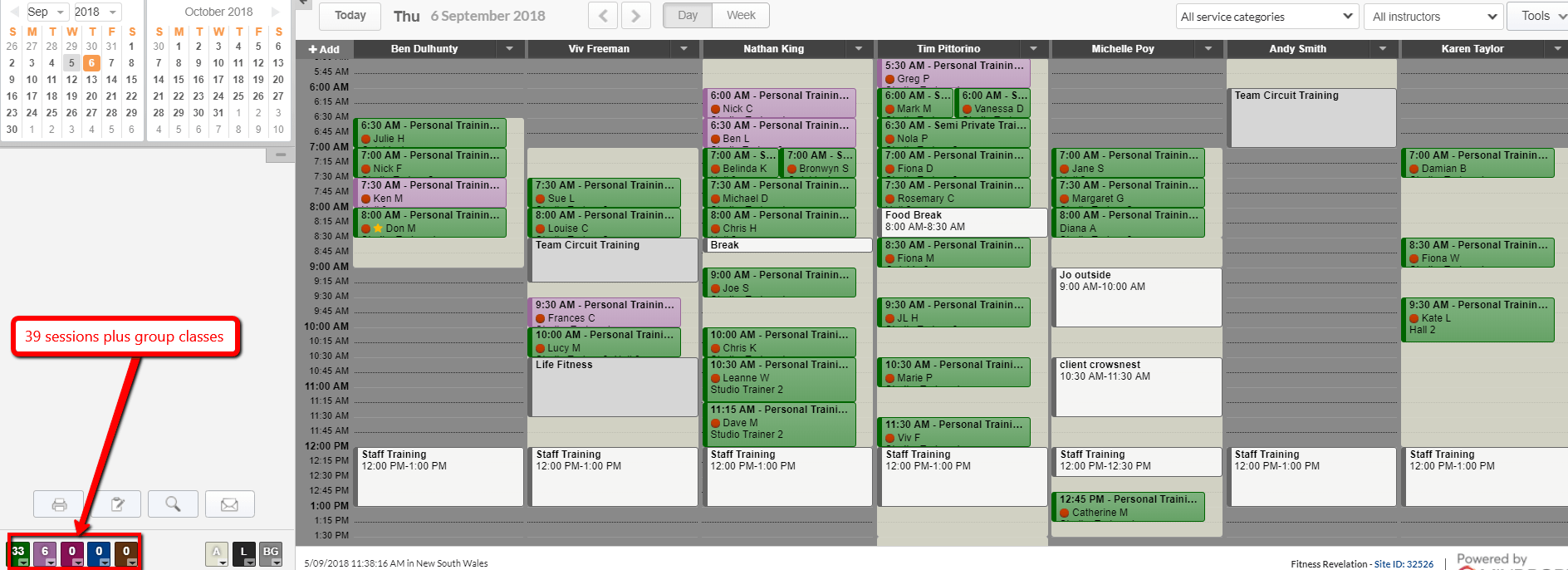11 Easy Tips to Boost Survey Response
We often reccomend surveys to our clients as a way to shape your fitness businesses direction, improve service, and make sure your operation is satisfying youe clients needs. While there is no doubt the information is useful the hard part is sometimes gathering an accurate sampling or a big enough pool of data to draw conclusions from. I stumbled upon this article and found it very useful so I thought I'd share.

Surveys are a powerful and cost-effective way to gather information, identify and diagnose problems, and uncover new and emerging opportunities. However, one of the biggest challenges that many companies face in conducting surveys is getting the right mix of people to take their surveys and also getting a high enough response rate in order to ensure that their survey results are accurate. The best way to calculate a survey response rate is to divide the number of surveys taken by the number of participants contacted. For example, if you contact 100 people and 30 people respond, you would have 30/100 = .3. Multiply .3 by 100% and your total response rate for that survey would be 30%. Survey response rates can vary widely depending on whether you are conducting your survey via phone, email, a paper survey, etc., what industry you're in, and whether your survey is going to customers or employees. Although there is no single way to improve your response rates, following are some easy steps that you can take that, when combined, will help you improve your survey response rates: 1. Know your survey audience Knowing your survey audience allows you to tailor all of your survey questions and communications to them. For example: Who are they? What type of topics are they interested in? When are they most likely to be available to take your survey? What is the best communication channel to use to reach them (e.g. online, e-mail, IVR, mobile, paper surveys, etc). Keep in mind that survey topics that may be of interest to some individuals or groups of people may be of little or no interest to others. What's more, people are more likely to respond to surveys from companies or people they know or have an existing relationship with vs. a stranger, so plan accordingly. 2. Keep your survey short The shorter your survey is the more likely people are to take it, and the higher your response rate will be. However, don't make your survey so short that you're not able to collect the information that you need. In general, try to develop a survey that is no more than 5-7 minutes long. Also, make it as easy as possible for participants to take your survey. For instance: 1) Provide respondents with a way to save partially completed surveys so that they can return and finish taking the survey later, if needed; 2) Put harder or more complex questions at the end (to reduce survey abandonment rates); and 3) Put any sensitive questions at the end (i.e. even if you tell people that your survey is being conducted anonymously, people still may not trust that and may abandon your survey once they come to a sensitive section. By asking this info, if needed, at the end, it will minimize your survey abandonment rates). 3. Ensure your contact list is up to date Make sure that you're working with an updated, clean and valid contact list. Otherwise, if you don't have a valid e-mail address for an e-mail survey or a valid mailing address for a paper survey, it will be difficult to deliver your survey, which will prevent some people from participating. 4. Conduct a pilot test Test your survey with a smaller group of people before sending it out to your entire survey participant list. By doing so, you'll be able to identify any issues that may exist with your survey or your contact list so that you can fix them before your survey goes out. Doing a pilot test will also give you a general idea of what you can expect to see in terms of an overall response rate once you send out your survey. 5. Be mindful of the timing and delivery of your survey Tuesdays through Thursdays are generally the best days of the week to send out a survey invitation for B2B surveys; the day of the week is less of an issue for B2C surveys. However, avoid busy times such as major holidays or major events such as a presidential election, etc., as these types of holidays and events will adversely affect your survey response rates. 6. Pre-notify those who you plan to survey Prior to sending out your survey, send out an announcement to all of those who you would like to participate in your survey. For the cost-conscious, announcements need not necessarily be sent via postcard or email. Perhaps you can include the announcement in your bill, in a newsletter, or on your website. In the announcement, let people know that you're planning to conduct a survey and when to expect it, provide a brief explanation about what the survey will be about and why you're conducting it, and explain why the survey is important (i.e. surveys that are perceived to be important achieve much higher response rates). In addition, include information such as how much time it will take for people to complete the survey, what you're planning to do with the survey results once you have them, and what your policy is for safeguarding people's personal information. Also, be sure to give people the option to opt out of taking your survey (i.e. an opt-out option should be included in all of the communications that are sent, including the survey invitation and reminder). 7. Send out a compelling survey invitation Create a survey invitation that is short and concise and that it is written in a friendly and welcoming tone. The invitation should be personalized with “Dear Susie Smith” and/or “We'd like your feedback about your service experience on Nov 1, 2009.” If you're sending out an email survey, use different subject lines for different groups to make them more relevant to your audience. For example, if you're sending out a product-related survey to your customers, you might use the subject: “Your use of our XYZ product”. Whereas, if you're sending out a survey to all of your employees, you might use “A message from our CEO”. The signature line needs to be from a top level executive related to the survey. For example, a survey related to support experience should likely come from the VP of Support, not the CEO. In the body copy of your survey invitation, be sure to include information such as: the purpose of the survey, why the survey is important, what you plan to do with the survey results, how long it will take to complete your survey, what the deadline is for completing the survey, information about whether or not the survey is being conducted anonymously, your contact information, and a signature of someone high-up in your organization (to increase the perceived importance of your survey). Also, to ensure that your survey invitation makes it into people's email in-boxes and doesn't get tagged as spam, be sure to read my other article on words to avoid so your emails get opened here 8. Send out reminder notices It's important to send out at least one reminder note to survey participants about three or five days after sending out your initial survey. Your reminder note should remind people that you need them to take the survey, convey a sense of urgency about the importance of taking the survey, restate the survey deadline, and stress why it's important for you to get their feedback. Allegiance typically encourages its clients not to send out more than two reminders per survey. Also, be sure to only send out a reminder to those who haven't yet taken your survey. The one exception is if your survey was conducted anonymously. In that case, consider sending out a reminder to everyone on your contact list. Otherwise, if people find out that some people received the reminder and others didn't, they may question whether or not the survey was conducted anonymously. 9. Offer an incentive for taking your survey. In some cases, offering people an immediate reward for taking your survey can help dramatically improve your survey response rates (more than 40% in some instances). Survey incentives can be a coupon, a gift card, cash, movie tickets, a discount off of a product or service, the chance to enter a drawing (i.e. fill out the survey and your name will automatically be entered into a drawing to win a big prize), etc. The point is to offer a survey incentive that your survey audience will care about and want. Also, keep in mind that survey incentives are commonly used for business-toconsumer surveys and less so for business-to-business (B-to-B) surveys, as there may be a conflict of interest policy prohibiting offering incentives for B-to-B surveys. It is advised that you use incentives sparingly and keep the “incentive” focused on how you can better meet your clients needs. 10. Get help for any areas that you're unsure about. If you're unsure about how to develop a survey questionnaire, which survey methodologies to use for a particular audience, whether or not to offer people an incentive to take your survey, and/or simply need help collecting your data, you may want to consider hiring a third-party vendor to help you with this. Doing so can save you a lot of time, headache and grief in conducting your surveys. Be sure to hire a firm that offers best practices support so that you will have all of the support you need throughout every stage of your project. 11. Act on and promote your survey results. Research shows that people are more likely to complete a survey if they believe that a company will act on the results. Whenever possible, publish your survey results and your company's plans to act on the results. In addition, promote the fact that your company is listening and what you've done with survey results. If people see a pattern in your company gathering and acting on survey data, they will be more inclined to take your surveys in the future, which will in turn, help improve your future survey response rates.
Yours in Fitness Business Success,

Ben Dulhunty











